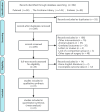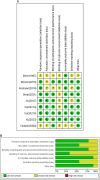Perioperative intravenous lidocaine infusion improves postoperative analgesia after hysterectomy: a systematic review and meta-analysis of randomized controlled trials
- PMID: 38976912
- PMCID: PMC11745622
- DOI: 10.1097/JS9.0000000000001942
Perioperative intravenous lidocaine infusion improves postoperative analgesia after hysterectomy: a systematic review and meta-analysis of randomized controlled trials
Abstract
Background: The effectiveness of intravenous lidocaine in reducing acute pain after hysterectomy remains uncertain. The authors conducted a meta-analysis of randomized controlled trials (RCTs) to investigate the impact of intravenous lidocaine on posthysterectomy recovery.
Methods: This study was completed based on the PRISMA guidelines and the Cochrane Handbook for Systematic Reviews of Interventions. A systematic search was conducted in PubMed/MEDLINE, the Cochrane Controlled Trials Register (CENTRAL), and Embase up to 27 July 2023. The authors identified RCTs involving hysterectomy patients comparing lidocaine to a placebo. Outcome measures included postoperative pain scores at rest and during movement, opioid consumption, postoperative nausea and vomiting (PONV), improvements in functional gastrointestinal recovery, and Quality of Recovery scores.
Results: Nine RCTs were included in the meta-analysis, comprising 352 patients who received intravenous lidocaine and 354 controls. The analysis revealed that intravenous lidocaine significantly reduced postoperative pain scores at rest at 2, 6, 8, and 24 h following hysterectomy, as well as postoperative opioid consumption within 24 h and PONV rates. Furthermore, no observed benefit was noted in shortening the time to first flatus with intravenous lidocaine administration posthysterectomy.
Conclusion: Intravenous lidocaine administration effectively reduces acute postoperative pain, opioid consumption, and PONV rates following hysterectomy. Lidocaine serves as an opioid-sparing agent, reducing the morphine equivalent dose while maintaining a similar degree of postoperative pain.
Copyright © 2024 The Author(s). Published by Wolters Kluwer Health, Inc.
Conflict of interest statement
The authors declare that they have no conflicts of interest.
Sponsorships or competing interests that may be relevant to content are disclosed at the end of this article.
Figures





Similar articles
-
Intravenous lidocaine on postoperative pain and opioid consumption during gynecological surgery: a meta-analysis of randomized controlled trials.Minerva Obstet Gynecol. 2024 Apr;76(2):181-187. doi: 10.23736/S2724-606X.22.05209-5. Epub 2022 Oct 18. Minerva Obstet Gynecol. 2024. PMID: 36255169
-
Effect of perioperative intravenous lidocaine infusion on postoperative recovery following laparoscopic Cholecystectomy-A randomized controlled trial.Int J Surg. 2017 Sep;45:8-13. doi: 10.1016/j.ijsu.2017.07.042. Epub 2017 Jul 10. Int J Surg. 2017. PMID: 28705592 Clinical Trial.
-
Perioperative systemic lidocaine for postoperative analgesia and recovery after abdominal surgery: a meta-analysis of randomized controlled trials.Dis Colon Rectum. 2012 Nov;55(11):1183-94. doi: 10.1097/DCR.0b013e318259bcd8. Dis Colon Rectum. 2012. PMID: 23044681
-
Efficacy of intravenous lidocaine on pain relief in patients undergoing laparoscopic cholecystectomy: A meta-analysis from randomized controlled trials.Int J Surg. 2018 Feb;50:137-145. doi: 10.1016/j.ijsu.2018.01.001. Epub 2018 Jan 10. Int J Surg. 2018. PMID: 29331604 Review.
-
Efficacy of intraoperative intravenous lidocaine for postoperative analgesia following bariatric surgery: a meta-analysis of randomized controlled studies.Surg Obes Relat Dis. 2022 Jan;18(1):135-147. doi: 10.1016/j.soard.2021.08.014. Epub 2021 Sep 1. Surg Obes Relat Dis. 2022. PMID: 34565683 Review.
Cited by
-
Effect of perioperative lidocaine infusion on the subjective quality of recovery after surgery: Protocol for an updated systematic review and meta-analysis.PLoS One. 2025 May 13;20(5):e0323342. doi: 10.1371/journal.pone.0323342. eCollection 2025. PLoS One. 2025. PMID: 40359208 Free PMC article.
References
-
- Weibel S, Jokinen J, Pace NL, et al. . Efficacy and safety of intravenous lidocaine for postoperative analgesia and recovery after surgery: a systematic review with trial sequential analysis. Br J Anaesth 2016;116:770–783. - PubMed
-
- Weinbroum AA. Non-opioid IV adjuvants in the perioperative period: pharmacological and clinical aspects of ketamine and gabapentinoids. Pharmacol Res 2012;65:411–429. - PubMed
-
- Nabata KJ, Guo R, Nguyen A, et al. . Superiority of non-opioid postoperative pain management after thyroid and parathyroid operations: a systematic review and meta-analysis. Surg Oncol 2022;41:101731. - PubMed
-
- Gilbert CR, Hanson IR, Brown AB, et al. . Intravenous use of xylocaine. Curr Res Anesthes Anal 1951;30:301–313. - PubMed
Publication types
MeSH terms
Substances
LinkOut - more resources
Full Text Sources
Medical

